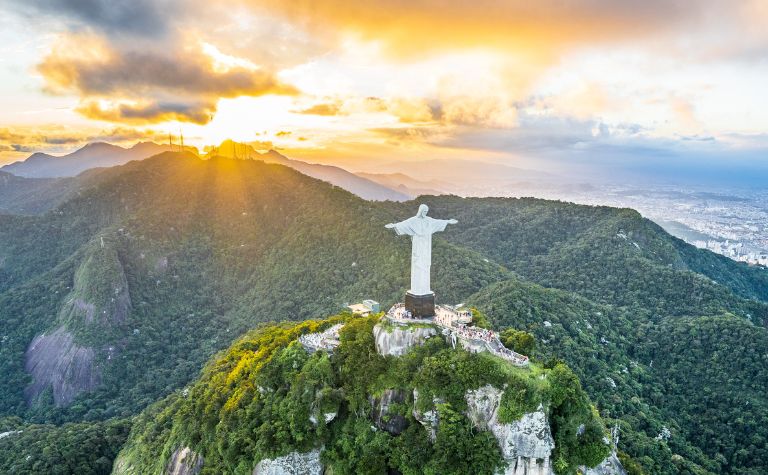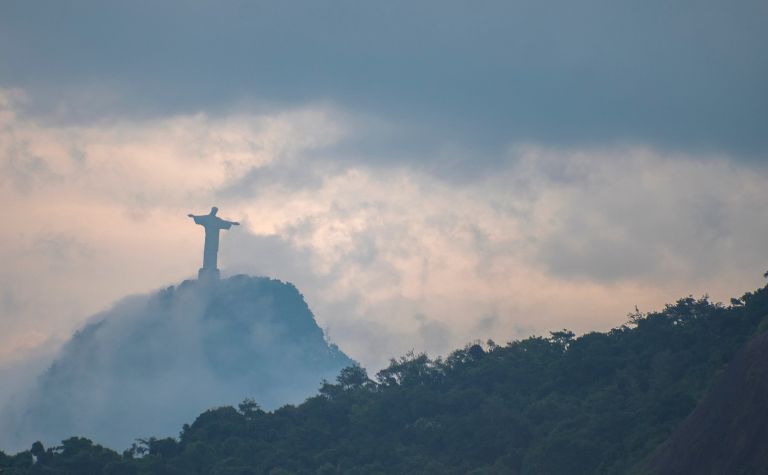Christ the Redeemer is a large soapstone statue located on the Corcovado mountain overlooking Brazil’s Rio de Janeiro. Since its construction, it has become one of the most well-recognized statues in the world and is widely considered a symbol of Christianity. So, who built the Christ the Redeemer statue?
Heitor da Silva Costa, a Brazilian engineer, built the Christ the Redeemer statue. However, many people helped him, including engineers Albert Caquot and Carlos Oswald, sculptor Gheorghe Leonida, and a large team of construction workers.
Read further to find out how many people worked on this famous statue’s construction. I’ll also explain how long its construction took and describe its dimensions.
Also see Where Is Christ the Redeemer? to learn more.

How many people worked on the statue’s construction?
Four people worked on the statue’s construction: Heitor da Silva Costa, Carlos Oswald, Paul Landowski, Albert Caquot, and Gheorghe Leonida. These men were responsible for the statue’s design, sculpting, and construction plans. However, large teams of builders helped them. Read further for more information on the people who worked on Christ the Redeemer’s statue:
Heitor da Silva Costa
Heitor da Silva Costa, a Brazilian civil engineer, was one of the many people who submitted design proposals for the Christ the Redeemer statue. [1] His winning design featured Christ holding a cross in one hand and a world globe in the other, which was later changed due to technical constraints.
Carlos Oswald
After Heitor da Silva Costa started planning the statue’s construction, he realized that it would be too challenging to erect it according to his initial design. He collaborated with Italian artist Carlos Oswald, who proposed a new design with Christ standing upright with his arms outstretched. [3]
Paul Landowski
Paul Landowski, a Polish-French sculptor, was another vital member of the statue’s design team. More specifically, Landowski designed and sculpted the statue’s hands. He made these out of clay and shipped them to Brazil, where the design and construction team carefully copied them and remade them out of reinforced concrete.
After the hands arrived in Brazil, a rumor started circulating that the statue was a gift from the French government. Still, it was soon discredited when the design team had to raise additional funds for materials. Most of the requested funds came from the Catholic church, which wanted to reintroduce Christianity into the city fully.
Albert Caquot
French-born Albert Caquot was one of the 20th century’s finest engineers. [2] Although he wasn’t involved in the statue’s design, he provided vital information on its dimensions and recommended the materials to be used.
Gheorghe Leonida
Gheorghe Leonida was a talented Romanian sculptor responsible for sculpting the statue’s head and face. [4] Leonida moved to Paris in 1924 to find his fortune and to look for work. Paul Landowski soon employed him to assist with the face’s finer details.
Construction Team
Most of the statue’s sculpting occurred at the mountain’s base. After each piece was completed, it was transported by train to the top and installed by large teams of construction workers.
The construction team performed all the heavy lifting under the instruction of the design team. In addition, they installed the statue’s six million mosaic tiles, sometimes writing personal notes behind them.
Although the construction workers climbed and descended the mountain every day and worked on the high scaffolding, there were no injuries or fatalities throughout the construction process.
Also see How Tall Is Christ the Redeemer? to learn more.

How long did it take to build the statue?
It took five years to build the statue. The foundation stone was installed on 4 April 1922, but construction only started in 1926 and was completed in 1931.
In 1922, the Brazilian authorities were still waiting for design submissions for the statue. However, they wanted to do something to commemorate Brazil’s centennial year of independence from Portugal and decided to install the foundation stone during a special ceremony.
Construction began in 1926, but the team soon realized the challenges surrounding the original design, and they stopped construction until the designers could create an improved design.
In 1928, the statue’s construction restarted, and the construction team built a sturdy metal frame to keep the statue attached to the base stone. After that, the reinforced concrete parts were installed and later covered by the soapstone mosaic tiles.
The statue was finally dedicated and officially completed on October 12, 1931.
The Christ the Redeemer statue was designed to be hardwearing and to require little maintenance. However, the Rio de Janeiro authorities conduct regular maintenance work to repair chips and refurbish them.
Before 2002, visitors to the statue had to climb 200 stairs, but the authorities installed escalators and elevators to make it more accessible.
The statue underwent its most extensive renovation in 2010 when it was thoroughly cleaned. The workers discovered large water pools in some of the crevices, which they removed, then applied waterproofing to the vulnerable areas. They replaced most of the statue’s soapstone parts during this restoration project.
The thorns on the statue’s head serve as lightning conductors; in December 2013, there was a violent thunderstorm, and one of the statue’s thumbs, fingers, and part of the head was damaged.
Also see How Was Christ the Redeemer Built? to learn more.

What Are Christ the Redeemer’s Dimensions?
Christ the Redeemer’s dimensions are 98 feet (30 meters) in height and 92 feet (28 meters) in width at the widest section of the outstretched arms. The statue weighs 635 metric tons and sits on a 26-foot (8 meters) high square base.
Christ the Redeemer is the world’s largest Art Deco statue, and you can see it from Sugarloaf Mountain. [5]
The statue’s base gives visitors a spectacular and panoramic view of the entire Guanabara Bay, and beyond. When the weather is clear, you can see all the way to Duque de Caxias, Sâo Gonçalo, and Niterói.
However, if you’d like a view from the top, you need to gain special permission from the Catholic church. There is a staircase inside the statue, but this is typically only for maintenance.
Also see Why Was Christ the Redeemer Built? to learn more.
Related Questions
The life of Jesus Christ continues to fascinate people more than 2,000 years after he walked the earth. The places where he called his disciples, preached about the Kingdom of God, and performed...
The crucifixion of Jesus Christ is one of the most important events in the Bible. Jesus' death on the cross, as well as his resurrection from the dead, are the climactic moments in the New Testament...
